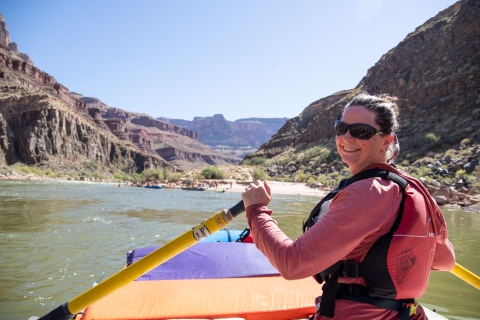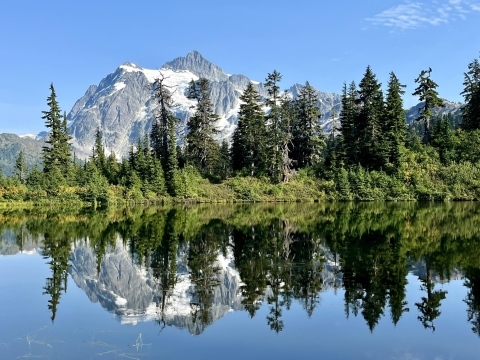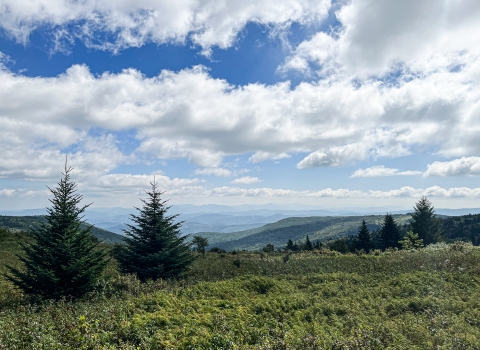By Jan Peterson, for the U.S. Fish and Wildlife Service
Katy Pfannenstein has built a life for herself that others may dream of. The U.S. Fish and Wildlife Service’s fish biologist focuses on habitat restoration and conservation in her role at the Mid-Columbia Fish and Wildlife Conservation Office in Leavenworth, Washington.
As a young girl, Pfannenstein was drawn to the outdoors – canoeing, hiking, climbing, and so much more. Over time, she explored ways to build a career in the great outdoors. Here, she talks about her journey and how she found her way to a career that not only brings her joy and leaves time for all of the outdoor pursuits she loves but will also help restore nature.
So, tell us a little about yourself and what sparked your interest in science and conservation.
I’ve always loved spending time in nature. My grandma lived on a lake near us in central Minnesota, so I grew up fishing, canoeing and camping on the weekends. The summer before my senior year in high school, I went on a month-long canoe trip in Canada, which sparked the desire to facilitate similar experiences with others to help them connect with nature. In college, I focused all my extracurricular activities on learning about environmental and outdoor education, wanting to gain the skillset to lead wilderness trips so others would want to help conserve the natural places that are special to them as well.
What did you study that helped you prepare for your current career path?
At the College of Saint Benedict, in Minnesota, I double majored in natural science and environmental studies. I took as many ecology-focused courses as I could, and all of my required coursework had an environmental theme.
After graduating, I worked in outdoor education. I guided mountaineering, rock climbing and white-water canoeing trips for Outward Bound in the summers and taught at the Academy of SOAR during the school year. SOAR is an alternative, wilderness-based boarding school for kids in grades 7 through 12 who have learning differences. We would go on expedition for two or three weeks at a time and use National Parks’ visitor centers for history and science. In addition, I taught a LOT of math on picnic tables.
But it turned out living out of a backpack year-round was hard on my system. In summer 2010, I got really sick in the field three times, so I knew something needed to change. I had a few different career paths that interested me: Guiding rock climbing day trips, nursing, teacher or fish biologist. After working one season in Wyoming as a fish technician, I was hooked (pun intended!) and I’ve never looked back.
I received my master’s degree in environmental science from Western Washington University in 2016. I researched water quality and algal dynamics in 10 mountain lakes. It wasn’t quite fish, but it was an excellent experience, and I work in restoring streams and watersheds now, so my coursework is quite applicable.
Let’s talk more about your career today. What does it mean to be a fish biologist with the Habitat and Restoration Program at the Service’s Mid-Columbia Fish and Wildlife Conservation Office?
In a nutshell, I provide technical and financial assistance to project partners, which include federal, Tribal, state, county, city, irrigation districts and nonprofit organizations. In other words, I wear many, many hats! My specialties include providing construction oversight, reviewing fish habitat restoration designs and writing grants. I also evaluate project proposals to be funded with federal funds from the National Fish Passage Program and Partners for Fish and Wildlife and from state funds through the Salmon Recovery Funding Board.
I also develop monitoring plans to assess the effectiveness of restoration projects, provide topographical surveys, analyze data and manage grants. The major projects I’m working on now are two funded through the Bipartisan Infrastructure Law Bipartisan Infrastructure Law
The Bipartisan Infrastructure Law (BIL) is a once-in-a-generation investment in the nation’s infrastructure and economic competitiveness. We were directly appropriated $455 million over five years in BIL funds for programs related to the President’s America the Beautiful initiative.
Learn more about Bipartisan Infrastructure Law : Gold Creek Restoration, in partnership with Kittitas Conservation Trust and Lower Toppenish Fish Passage and Ecosystem Restoration, in partnership with Yakama Nation.
What do you do for fun?
I love being outside, especially in the mountains! I love rock climbing, mountain climbing, trail running, mountain biking, Nordic skiing, backcountry skiing and packrafting. I also like to make art. I love photography, creating linocuts and sewing.
How have your experiences in the outdoors influenced how you approach your work?
While working in outdoor education, I was able to refine my leadership, teamwork, communication and conflict-management skills, all of which are very applicable to my job today. In fact, I use them more frequently than my biology and technical restoration skills! Many of the projects I work on are in the Yakima River Basin, where partners are working collaboratively to provide solutions for decreasing water supplies for fish, farms and families. I love that my job allows me to utilize my strengths and to work with so many amazing partners to find real-world solutions to real-world problems.
Who do you look up to?
Honestly, I look up to the older women I see on the trails in the mountains and who still rock climb! (But I just realized I might be entering that category as I see younger women on the trails! LOL!) I also look up to folks who have found a work/life balance, working a job they are passionate about while finding the time to enjoy enough adventures, exercise, sleep and eating well.
Is there anything else you’d like to share about yourself, personally or professionally?
It’s really great to be able to utilize all the different skills I’ve obtained over the years, having them come together in my current career. When I worked in the hatchery evaluation program at the Mid-Columbia FWCO, I was excited to be working in the field and analyzing data, but I didn’t get to use my people skills as much as I would have liked. But now, in the habitat restoration program, I get to use all of my skills –fieldwork, leadership and data analyses. My husband and I originally moved to Leavenworth for the rock climbing and I really feel like I won the career lottery here at the Mid-Columbia FWCO!
Our public lands, like our roads and bridges, require strategic investments and management to protect the fish and wildlife that is so important to the American public. Projects like those Katy Pfannenstein are working on are possible thanks to the Bipartisan Infrastructure Law, which has committed $455 million to the U.S. Fish and Wildlife Service over five years to support our natural infrastructure and protect these valuable resources.







